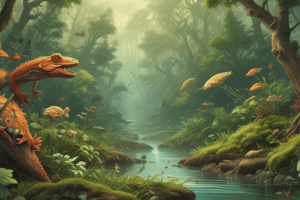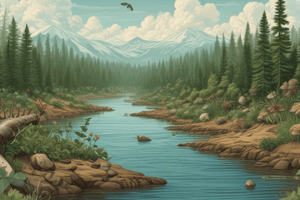Podcast
Questions and Answers
Which plant is categorized as an invasive species?
Which plant is categorized as an invasive species?
- Fireweed
- Burr Oak
- Creeping Bellflower (correct)
- Tamarack/Larch
What does the term 'Honorable Harvest' primarily refer to?
What does the term 'Honorable Harvest' primarily refer to?
- Using machinery for agricultural productivity
- Gathering plants in a sustainable manner (correct)
- Harvesting animals in their natural habitat
- Effective fishing techniques
Why was Canada Thistle named as such?
Why was Canada Thistle named as such?
- It is primarily used in Canadian cuisine
- It was first discovered by Canadian botanists
- It is only found in Canada
- Early residents blamed its emergence on French traders from Canada (correct)
Which of the following plants is identified as a native species?
Which of the following plants is identified as a native species?
Which concept is NOT part of the energy and matter framework in the biosphere?
Which concept is NOT part of the energy and matter framework in the biosphere?
What is the main theme of the topics listed under 'Energy in the Biosphere'?
What is the main theme of the topics listed under 'Energy in the Biosphere'?
Which tree is described as native in the context provided?
Which tree is described as native in the context provided?
Which of the following best defines a biogeochemical cycle?
Which of the following best defines a biogeochemical cycle?
What is the purpose of the Bromothymol Blue (BTB) solution in the investigation?
What is the purpose of the Bromothymol Blue (BTB) solution in the investigation?
Which test tube serves as the control group in the investigation?
Which test tube serves as the control group in the investigation?
What is the manipulated variable in the experiment?
What is the manipulated variable in the experiment?
Which variable is being measured as the responding variable?
Which variable is being measured as the responding variable?
What controlled variable ensures that all test tubes are treated equally regarding environmental factors?
What controlled variable ensures that all test tubes are treated equally regarding environmental factors?
Why is it important for the test tubes to be sealed in a closed environment?
Why is it important for the test tubes to be sealed in a closed environment?
Which treatment group contains both a plant and an animal in the same test tube?
Which treatment group contains both a plant and an animal in the same test tube?
What is a controlled variable that affects the outcome of the experiment?
What is a controlled variable that affects the outcome of the experiment?
What does the term 'biomass' refer to in an ecosystem?
What does the term 'biomass' refer to in an ecosystem?
What is referred to by the term 'GAIA Hypothesis'?
What is referred to by the term 'GAIA Hypothesis'?
What does the term 'productivity' describe?
What does the term 'productivity' describe?
What does the covenant of reciprocity between humans and the living refer to?
What does the covenant of reciprocity between humans and the living refer to?
What was 'Biosphere II' intended to simulate?
What was 'Biosphere II' intended to simulate?
What must humans provide in exchange for the lives they take from nature?
What must humans provide in exchange for the lives they take from nature?
What does 'equilibrium' refer to in ecological terms?
What does 'equilibrium' refer to in ecological terms?
Which of the following is a guideline for sustainable harvesting?
Which of the following is a guideline for sustainable harvesting?
What should one do before taking resources from nature?
What should one do before taking resources from nature?
What is the recommended approach to harvesting in nature?
What is the recommended approach to harvesting in nature?
What is emphasized regarding the use of resources taken from nature?
What is emphasized regarding the use of resources taken from nature?
Why is it important to share resources gathered from nature?
Why is it important to share resources gathered from nature?
What is the significance of recognizing that every breath taken comes from plants?
What is the significance of recognizing that every breath taken comes from plants?
Which law of thermodynamics states that energy cannot be created or destroyed?
Which law of thermodynamics states that energy cannot be created or destroyed?
What is implied by the statement 'Energy Input = Desired Energy + Waste Energy'?
What is implied by the statement 'Energy Input = Desired Energy + Waste Energy'?
What type of diagram representing trophic levels is suggested in the content?
What type of diagram representing trophic levels is suggested in the content?
In constructing a food chain, which of the following is the primary producer?
In constructing a food chain, which of the following is the primary producer?
What role did cyanobacteria play in changing the atmosphere of early Earth?
What role did cyanobacteria play in changing the atmosphere of early Earth?
What is the relationship between energy input and energy output as described in the content?
What is the relationship between energy input and energy output as described in the content?
Which of the following statements about the first law of thermodynamics is correct?
Which of the following statements about the first law of thermodynamics is correct?
What is a significant characteristic of stromatolites?
What is a significant characteristic of stromatolites?
What does the term 'waste energy' refer to in energy transformations?
What does the term 'waste energy' refer to in energy transformations?
What was a major challenge faced by closed system simulations like Biosphere 2?
What was a major challenge faced by closed system simulations like Biosphere 2?
Which statement correctly illustrates the second law of thermodynamics?
Which statement correctly illustrates the second law of thermodynamics?
How can human activity disrupt the natural balance of ecosystems?
How can human activity disrupt the natural balance of ecosystems?
What does the Gaia Hypothesis suggest about organisms and the environment?
What does the Gaia Hypothesis suggest about organisms and the environment?
What is a potential solution for humans to reduce their environmental impact?
What is a potential solution for humans to reduce their environmental impact?
Which ancient life form is primarily responsible for the formation of stromatolites?
Which ancient life form is primarily responsible for the formation of stromatolites?
What does the presence of iron-oxide layers in stromatolites indicate?
What does the presence of iron-oxide layers in stromatolites indicate?
Flashcards
Native Species
Native Species
A term that describes a plant that originated in a particular geographic area and evolved naturally within that region.
Invasive Species
Invasive Species
A plant species that was introduced to a new area and has become established, often outcompeting native species.
Fireweed
Fireweed
A tall, showy wildflower with bright yellow blooms commonly found in disturbed areas.
Larch
Larch
Signup and view all the flashcards
Creeping Bellflower
Creeping Bellflower
Signup and view all the flashcards
Burr Oak
Burr Oak
Signup and view all the flashcards
Canada Thistle
Canada Thistle
Signup and view all the flashcards
Honorable Harvest
Honorable Harvest
Signup and view all the flashcards
Equilibrium
Equilibrium
Signup and view all the flashcards
Biomass
Biomass
Signup and view all the flashcards
Biosphere II
Biosphere II
Signup and view all the flashcards
Gaia Hypothesis
Gaia Hypothesis
Signup and view all the flashcards
Productivity
Productivity
Signup and view all the flashcards
System
System
Signup and view all the flashcards
Bromothymol Blue (BTB)
Bromothymol Blue (BTB)
Signup and view all the flashcards
Biosphere
Biosphere
Signup and view all the flashcards
Scientific Investigation
Scientific Investigation
Signup and view all the flashcards
Covenant of Reciprocity
Covenant of Reciprocity
Signup and view all the flashcards
Manipulated Variable
Manipulated Variable
Signup and view all the flashcards
Responding Variable
Responding Variable
Signup and view all the flashcards
Attention to the Things Whose Lives We Take
Attention to the Things Whose Lives We Take
Signup and view all the flashcards
Controlled Variables
Controlled Variables
Signup and view all the flashcards
Never Take the First, Never Take the Last
Never Take the First, Never Take the Last
Signup and view all the flashcards
Control Group
Control Group
Signup and view all the flashcards
Treatment Groups
Treatment Groups
Signup and view all the flashcards
Harvest in a Way that Does the Least Harm
Harvest in a Way that Does the Least Harm
Signup and view all the flashcards
Share with Others
Share with Others
Signup and view all the flashcards
Closed Environment
Closed Environment
Signup and view all the flashcards
First Law of Thermodynamics
First Law of Thermodynamics
Signup and view all the flashcards
Second Law of Thermodynamics
Second Law of Thermodynamics
Signup and view all the flashcards
Food Web
Food Web
Signup and view all the flashcards
Food Chain
Food Chain
Signup and view all the flashcards
Producers
Producers
Signup and view all the flashcards
Consumers
Consumers
Signup and view all the flashcards
Decomposers
Decomposers
Signup and view all the flashcards
Trophic Levels
Trophic Levels
Signup and view all the flashcards
Homeostasis
Homeostasis
Signup and view all the flashcards
Stromatolites
Stromatolites
Signup and view all the flashcards
Photosynthesis
Photosynthesis
Signup and view all the flashcards
Anoxic Atmosphere
Anoxic Atmosphere
Signup and view all the flashcards
Oxic Atmosphere
Oxic Atmosphere
Signup and view all the flashcards
Closed System Simulations
Closed System Simulations
Signup and view all the flashcards
Human Interference
Human Interference
Signup and view all the flashcards
Study Notes
Unit A: Energy & Matter in the Biosphere
- This unit covers energy and matter in the biosphere, specifically Chapters 1 & 2.
- Topics include Energy in the Biosphere, Energy Transfer in the Biosphere, Water, Biogeochemical Cycles, Productivity & Equilibrium.
- The Honorable Harvest is a presentation about native plants in and around the Edmonton area.
- The presentation included examples of native plants, identifying native versus invasive species, and distinguishing characteristics of native species.
- Questions included: Identifying native species versus invasive weeds, distinguishing characteristics, common names, if the plant is a native species or an invasive weed, and common names for different trees such as the Tamarack/Larch.
- Various questions, including those about a covenant of reciprocity between humans and the living, responsibility towards nature, sustainable harvesting, and the interconnectedness of all living things in the biosphere were presented.
The Earth's Spheres
- The Earth is a system composed of four interacting spheres: lithosphere (land), hydrosphere (water), atmosphere (air), and biosphere (living things).
- The focus is on the biosphere and its interaction with the other spheres.
Earth Spheres Details
- Lithosphere: Solid Earth
- Hydrosphere: All water found on, under, and over the surface of Earth
- Atmosphere: Gases that surround Earth (its air)
- Biosphere: All life on Earth
The Biosphere
- The biosphere is a system because living things interact with their surroundings.
- Examples of components interacting with their surroundings are birds in the air, sea creatures, marine living organisms, microscopic organisms, animals in the ground, and vegetation (dead plants and animals).
Abiotic and Biotic Factors
- The biosphere involves interactions between biotic (living or once living) and abiotic (non-living) factors.
- Biotic factors include bacteria, fish, birds, mammals, and plants, and their remains.
- Abiotic factors include temperature, weather, soil acidity, and sunlight.
- The study of interactions between biotic and abiotic factors is called ecology.
Types of Systems
- A biological system describes the interactions that living things have with their environment.
- Open Systems: Both matter and energy can enter and leave the system (e.g., the biosphere).
- Closed Systems: Only energy can enter and leave the system; matter cannot (e.g., Earth).
Ultimate Source of Energy
- Energy on Earth originates from the sun (radiant energy).
- The three outcomes of solar energy are 30% gets reflected by clouds, dust particles, water and land, 19% is absorbed by the atmosphere and clouds, and 51% is absorbed by the earth's surface. 1-2% of the 51% absorbed is captured by producers.
Albedo Effect
- Albedo is the amount of reflected energy.
- Light-colored surfaces have a high albedo (reflect light energy).
- Dark-colored surfaces have a low albedo (absorb sun's energy).
- Examples include snow (high albedo) and asphalt (low albedo).
The Need for Energy
- Photosynthesis: Plants use CO2 and H2O to produce glucose and oxygen, using the sun's energy.
- Cellular Respiration: Organisms use glucose and oxygen to produce energy (ATP), releasing CO2 and H2O.
Chemosynthesis
- Chemosynthesis is energy production in the absence of sunlight.
- It uses chemicals like hydrogen sulfide to produce energy.
- Example organisms are bacteria in deep-sea thermal vents.
One Way Flow of Energy
- Energy enters the biosphere as radiant energy from the sun.
- Energy flows from producers to consumers.
- Matter is recycled through living things.
First Law of Thermodynamics
- Energy cannot be created or destroyed, only changed in form.
Investigation: Radiant Energy Stored in Plants
- During photosynthesis, plants convert radiant energy into chemical energy in the form of glucose, which is then stored as starch.
- Lugol's Iodine is used to test for the presence of starch.
Investigation: Carbon Dioxide Production in Plants and Animals
- This investigation compares carbon dioxide production in plants (Elodea) and animals (snails) in a closed environment.
- Using Bromothymol blue (BTB) as an indicator, the investigation observed how the colour change of the BTB solution can indicate the level of Carbon Dioxide present.
Video Tutorials
- Links provided to videos on YouTube for further learning on various topics like the energy of the Earth, energy transfer, the water cycle, the carbon cycle, net primary productivity, and the Gaia Hypothesis.
Topic 2: Energy Transfer in the Biosphere
- Food chains and food webs describe energy transfer.
- Each transfer from one organism to another is only 10% efficient; the rest becomes heat.
- Producers use photosynthesis to generate their own food, and consumers acquire energy from other organisms.
- Different consumers, such as primary, secondary, and tertiary consumers, are part of a food web.
- Decomposers are important for nutrient recycling.
Ecosystem Definitions
- An ecosystem is a smaller system within the biosphere, and includes both biotic (living) and abiotic (non-living).
- Biotic interaction refers to the interaction between different species within an ecosystem.
- Abiotic interaction refers to the interaction between species and the non-living parts of the ecosystem.
Modes of Nutrition
- Autotrophs (e.g., plants, algae) produce their own food through photosynthesis or chemosynthesis.
- Heterotrophs (e.g., animals, fungi) obtain energy by consuming other organisms.
Trophic Levels
- Trophic levels describe the stages of an organism in a food chain or web based on how many energy transfers away from the original radiant energy. A trophic level describes the energy transfer steps from producer to consumer.
- The higher the trophic level, the further away from the original energy. Typically, 10% of energy is transferred; the rest is lost as heat.
Models of Trophic Levels
- Food chains show a linear feeding relationship.
- Food webs show interacting food chains.
- Ecological pyramids show quantitative values for each trophic level.
Ecological Pyramids
- Pyramid of Numbers: Depicts the approximate number of organisms at each level.
- Pyramid of Biomass: Depicts the total mass of organisms at each level.
- Pyramid of Energy: Depicts the amount of energy at each level.
Second Law of Thermodynamics
- During energy conversion, some energy is lost as heat.
- Only about 10% of energy is transferred between trophic levels.
Case Studies
- The impacts of an endangered ecosystem are examined.
- The impact of humans on the earth are examined through simulations, such as, Biosphere 2.
Topic 3: Water
- Water is a precious and limited resource that must be recycled through the hydrological cycle.
- Key processes include precipitation, condensation, runoff, and evaporation/transpiration/respiration.
Water's Properties
- Water has unique properties due to its polarity, hydrogen bonding, thermal properties, and cohesive properties.
- Water's structure is built upon covalent bonding.
- Water's polarity leads to hydrogen bonding.
- Water's properties allow it to act as a universal solvent.
Topic 4: Biogeochemical Cycles
- Biogeochemical cycles describe the pathway matter takes as it is recycled and reused.
- Examples include the carbon-oxygen, nitrogen, and phosphorus cycles.
- Cycles have fast and slow components, and can be disrupted by human activities.
Topic 5: Productivity & Equilibrium
- Productivity is the rate at which biomass is generated.
- Productivity is affected by factors like sunlight and moisture.
- Equilibrium is the balance between interacting forces in the biosphere.
Studying That Suits You
Use AI to generate personalized quizzes and flashcards to suit your learning preferences.




